Investing in 2023? In the face of adversity – farmland remains a safe bet
Our most recent farmland research shows that agricultural land was the top-performing asset class in 2022. The head of our Farms and Estates team, Will Matthews, outlines why this is the case.
3 minutes to read
The UK is identified by many as a reliable option for investment in farmland for several reasons. Demand is currently extremely high, with many properties being sold off market. In fact, last year, 60% of the properties our Farms and Estates team sold were off market. Will Matthews, Head of Knight Frank’s Farms and Estates team, explains why.
Agricultural land top-performing asset class in 2022
Our latest farmland research reveals that agricultural land was the top-performing asset class in 2022 (a rise of 13%), outperforming other asset classes such as gold, equities and residential property. This highlights farmland’s role as a hedge against inflation, particularly amid economic turbulence and political changes afoot. While in relation to other asset classes, it is typically low yielding, this is mitigated by the provision of a safe haven and helps balance the investor’s portfolio. There is certainly still an appetite for investment in agricultural land, principally due to the security of the asset class, as well as the potential income generation and tax advantages.

Environmental latent value
There are numerous opportunities for an uplift in value and income potential for marginal land which are unsuited to commercial agriculture. There are multiple opportunities with alternative uses for biodiversity, carbon offsetting, renewables and tree planting which will benefit from both private and public sector funding. We’ve seen a whole new raft of buyers coming into the market focused on environmental enhancement and “rewilding”.
Agricultural land tax efficiencies
Agricultural land is currently efficient from an Inheritance Tax (IHT) perspective. The government has launched a consultation to explore elements of the tax treatment of ecosystem service markets and environmental land management. We understand this will look at the scope of Agricultural Property Relief (APR), which has historically been a favourable benefit for landowners. APR is only available in respect of land occupied for the purposes of agriculture – and so the concern is that aspects of environmental land management may not qualify. APR includes ‘land not currently being farmed under the Habitat Scheme’ (subsumed into the existing Countryside Stewardship Schemes). So with the significant changes to government policy and the environmental drivers, we hope this will broaden and extend to include land subject to environmental land management. Still, we cannot assume this is definitive.
It is essential that land forms part of the trading business to qualify for Business Property Relief (BPR). This can be achieved through ‘insetting’, by using and managing the land as part of your trading business, to include any environmental benefits achieved. BPR is in many ways preferable as it offers 100% Business Relief, rather than just relief on the ‘agricultural value’ as with APR.

Farmland supply holding value
Ultimately the basic function of significant and increasing demand for farmland and the historically low supply levels are holding up values. However, this isn’t necessarily a negative as it reinforces land as an asset class of choice – and quite simply – it is a finite resource!
How can our Farms and Estates Team help you?